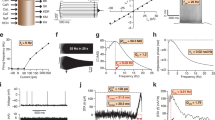Abstract
Arising from: B. Naundorf, F. Wolf & M. Volgushev Nature 440, 1060–1063 (2006); Naundorf et al. reply
Action potentials in cortical neurons show a variable threshold and a sudden rise in membrane potential at initiation. Naundorf et al.1 fail to explain these features using single- or double-compartment Hodgkin–Huxley-style models, suggesting instead that they could arise from cooperative opening of Na+ channels, although there is no direct biological evidence to support this. Here we show that these so-called unique features are to be expected from Hodgkin–Huxley models if the spatial geometry and spike initiation properties of cortical neurons are taken into account — it is therefore unnecessary to invoke exotic channel-gating properties as an explanation.
This is a preview of subscription content, access via your institution
Access options
Subscribe to this journal
Receive 51 print issues and online access
$199.00 per year
only $3.90 per issue
Buy this article
- Purchase on Springer Link
- Instant access to full article PDF
Prices may be subject to local taxes which are calculated during checkout


Similar content being viewed by others
References
Naundorf, B., Wolf, F. & Volgushev, M. Nature 440, 1060–1063 (2006).
Palmer, L. M. & Stuart, G. J. J. Neurosci. 26, 1854–1863 (2006).
Stuart, G., Schiller, J. & Sakmann, B. J. Physiol. 505, 617–632 (1997).
Shu, Y., Duque, A., Yu, Y., Haider, B. & McCormick, D. A. J. Neurophysiol. doi:10.1152/jn.00922.2006 (2006).
Pare, D., Shink, E., Gaudreau, H., Destexhe, A. & Lang, E. J. J. Neurophysiol. 79, 1450–1460 (1998).
Shu, Y., Hasenstaub, A., Duque, A., Yu, Y. & McCormick, D. A. Nature 441, 761–765 (2006).
Colbert, C. M. & Johnston, D. J. Neurosci. 16, 6676–6686 (1996).
Coombs, J. S., Curtis, D. R. & Eccles, J. C. J. Physiol. 139, 232–249 (1957).
Shu, Y., Hasenstaub, A., Badoual, M., Bal, T. & McCormick, D. A. J. Neurosci. 23, 10388–10401 (2003).
Inda, M. C., DeFelipe, J. & Munoz, A. Proc. Natl Acad. Sci. USA 103, 2920–2925 (2006).
Komada, M. & Soriano, P. J. Cell Biol. 156, 337–348 (2002).
Colbert, C. M. & Pan, E. Nature Neurosci. 5, 533–538 (2002).
Mainen, Z. F. & Sejnowski, T. J. Nature 382, 363–366 (1996).
Baranauskas, G. & Martina, M. J. Neurosci. 26, 671–684 (2006).
Author information
Authors and Affiliations
Rights and permissions
About this article
Cite this article
McCormick, D., Shu, Y. & Yu, Y. Hodgkin and Huxley model — still standing?. Nature 445, E1–E2 (2007). https://doi.org/10.1038/nature05523
Published:
Issue Date:
DOI: https://doi.org/10.1038/nature05523
This article is cited by
-
Voltage sensors of a Na+ channel dissociate from the pore domain and form inter-channel dimers in the resting state
Nature Communications (2023)
-
Single-compartment model of a pyramidal neuron, fitted to recordings with current and conductance injection
Biological Cybernetics (2023)
-
Low-dimensional models of single neurons: a review
Biological Cybernetics (2023)
-
Projection-Specific Heterogeneity of the Axon Initial Segment of Pyramidal Neurons in the Prelimbic Cortex
Neuroscience Bulletin (2023)
-
Resurgent Na+ currents promote ultrafast spiking in projection neurons that drive fine motor control
Nature Communications (2021)
Comments
By submitting a comment you agree to abide by our Terms and Community Guidelines. If you find something abusive or that does not comply with our terms or guidelines please flag it as inappropriate.



